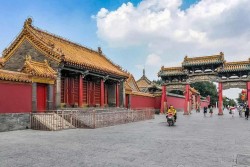

Introducing Imperial Palace
Shenyang Imperial Palace is the most ancient imperial architectural complex of the Qing Dynasty next only to the Forbidden City in Beijing in historical and artistic value. Shenyang Imperial Palace, also called Shengjing Imperial Palace, was first built in 1625 by Nurhachi (1559-1626), the Manchu chieftain who became the first king of the Jin State (established 1616), and excessively extended by Huangtaiji (1592-1643), his son and successor before they brought all China under their rule and established the Qing Dynasty. Besides the Forbidden City in Beijing, Shenyang Imperial Palace is the only other existing palace complex in China. Within its walls much is revealed about the early Qing Dynasty. Shenyang Imperial Palace was listed by UNESCO as a World Cultural Heritage Site in 2004 as an extension of the Forbidden City and is now the most popular and renowned tourist attraction in Shenyang.
Imperial Palace Fast Facts
• Chinese Name: Shen Yang Gu Gong 沈阳故宫
• Best Time to Visit: April to October
• Recommended Visiting Hours: About 2 to 3 hours
• Things to Do: Photography, Architecture, Qing Dynasty Culture
• Opening Hours: 8:30-17:30 from Apr 10 to Oct 10; 09:00-16:30 from Oct 11 to April 9; Tuesday to Sunday
• Entrance Fee: CNY 60
• Address: No. 171 Shenyang Road, Shenhe District, Shenyang, Liaoning Province
What to expect at Imperial Palace
Covering an area of more than 60,000 square meters (about 71,760 square yards), Shenyang Imperial Palace is one twelfth the size of the Forbidden City in Beijing. Shenyang Imperial Palace consists of more than 300 rooms, formed around 20 courtyards. Shenyang Imperial Palace can be divided into three sections-the eastern section, the middle section and the western section. Each section boasts of unique characteristics.
The eastern section of Shenyang Imperial Palace contains the very impressive Hall of Great Affairs (Da Zheng Dian). Here emperors ascended the throne, enacted imperial edicts, and welcomed victorious generals and soldiers. A group of pavilions, known as the Ten Kings Pavilion, stand to its east and west. They formerly served as the place where emperors and leaders from the eight banners (Ba Qi) settled national affairs. This architectural style of Shenyang Imperial Palace is unique. The style of the buildings, which displays an amalgamation of Han, Manchu and Mongolian cultures, all originated from the shape of a nomadic tent. The eastern section of Shenyang Imperial Palace is representative of the whole palace.
The middle section starts from the Da Qing Gate, with Chong Zheng Dian (Jin Luan Dian), the Phoenix Tower and Qingning Palace arranged on a central axis from south to north. Chong Zheng Dian is the place where Abahai held court. It is the most important building in Shenyang Imperial Palace. The Phoenix Tower, a three-storied building, was the highest structure in the whole city at that time. Qingning Palace was the bedchamber for Abahai and his concubines.
The western section was constructed by order of Emperor Qianlong (1711-1799). Its main structure is the Wen Su Pavilion. In front of this, there are the Opera Stage and Jiayin Hall and behind it is the Yang Xi Room. The Wen Su Pavilion, which contains the Complete Collection of Four Treasures, has a black roof because black was considered to represent water which could be used to extinguish a fire to protect the priceless books contained inside.
Shenyang Imperial Palace houses many ancient cultural relics, such as Nurhachi's sword and Abahai's broadsword. There are also many artworks displayed here, such as paintings, calligraphy, pottery, sculptures and lacquer ware.
How to get to Imperial Palace
• Imperial Palace can be reached by bus 117, 118, 132, 140, 213, 215, 222, 228, 251, 276, 287, 290, 292, 296 and Metro Line 1.
• Rent a car/bus from GGC to enjoy a hassle free private transfer from hotels in Shenyang to Imperial Palace.
Additional travel advice on Imperial Palace
• Imperial Palace is closed on Mondays except for public holidays.
• Visitors can deposit baggage at the entrance of Daqing Gate and Siwen Gate. The deposit service at Siwen Gate is not available in winter time.